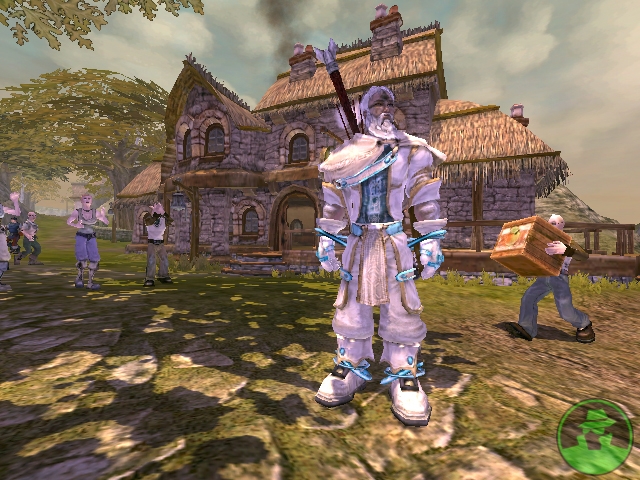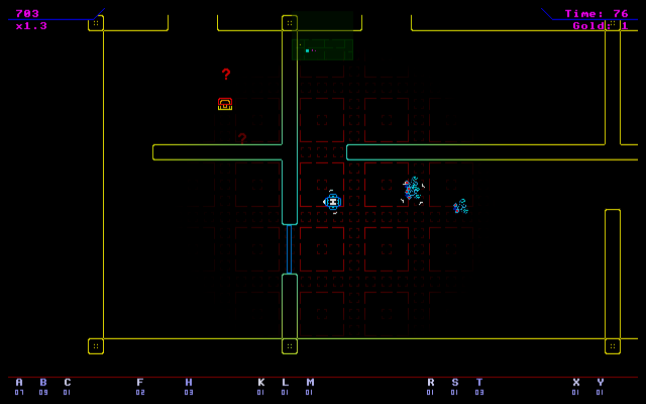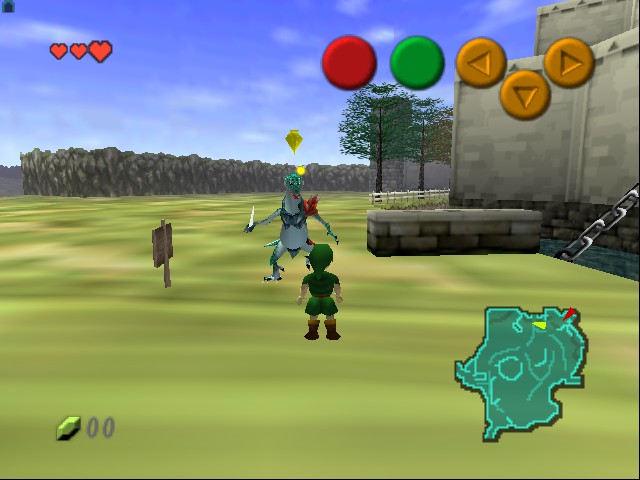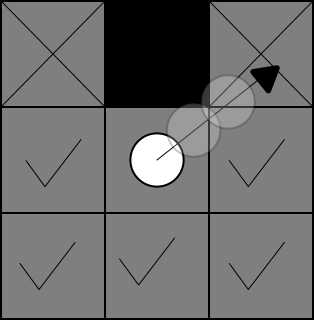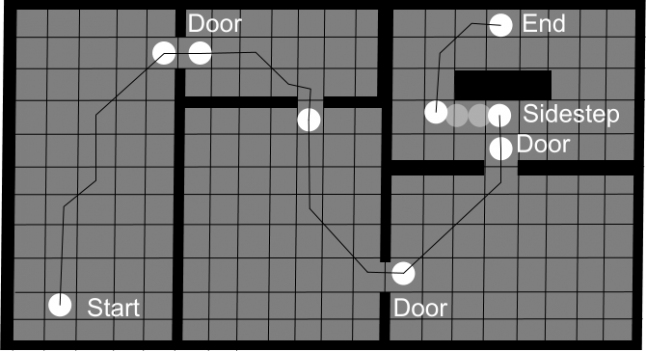Rejecting Black Boxes: Or - 'Punk Approaches to A.I. and Navigation for Indie Developers'10/23/2015 Introduction of Manifest Pomposity Far back in the mists of time, when games were a new thing, and nobody knew what they were doing, before 'best practices', 'accepted algorithms' and 'standard toolsets' and 'weird sets of words in quotes for no good reason', people were making some amazing games. Download Mame and - after deleting all but about 20 of the quadrillion games it comes with - you'll see that what you're left with is A-MAZING. No, really. In those days, developers looked at their game's requirements and developed exactly what they needed. Nothing more, nothing less. Today, many developers solve their problems by putting together a gigantic lego-stack of black-boxed rendering, physics and A.I./Navigation technology, believing there is no reasonable alternative. I'm going to suggest that there are alternatives to this approach. I'll focus on Spellrazor's A.I. in particular, and hopefully make you consider whether middleware, A* or State Machines are really necessary in your case. A Butterfly's Inner World: Or 'Random Fable Anecdote' In Fable 1 we had pretty little towns and villages filled with complex A.I. behaviour. Try following one person around a village for a full game-day. You'll be impressed at what they get up to. Did you know that villagers get into bed? I don't mean just lie on top of the beds. I mean actually fold back the sheets and get into bed. No? That's because nobody ever went into houses at night because they were locked. Oh, you could break down the door but nobody ever did, and you'd get arrested if you were spotted anyway. We actually discouraged players from seeing it. (Note: we dropped the entire behaviour set for Fable 2, along with many others such as children's school days. Nobody noticed) Earlier in the game's development we found out that the villager A.I. was taking a ridiculous amount of processing time. We added various logs and other debugging tools in order to track down the problem. It was only after someone's careless sword-swing smacked into a butterfly that we understood what was wrong. The butterfly yelled 'Help' and then A* navigated its way to a village exit whereupon it disappeared up a trade-route. Someone had made the default behaviour 'human'. I mention this as an illustration to hilight that 'Best' is not always 'Appropriate', though many would have you believe so. They should be flogged. Gently. With something moist. Spellrazor: Or 'What Does Your Game Actually Need?' Spellrazor is my ridiculous '80s game resurrection project. It's a top-down rogue-lite dungeon shooter for PC and Mac with 27 fire buttons and a host of different enemies. The game goes into a kind of bullet-time when you're in danger, allowing you to use those those 27 spells tactically - even in the midst of a complex firefight. Nono. Ignore the picture. It's not the same as actually playing the game in all its throbbing neon-tinged glory. Just pretend I didn't put the picture up at all. Keep scrolling. Bit more. Stop! That's better. Spellrazor is of the same school of thought as old Williams classics like Robotron and Defender. It's sinister, it's deadly, and its enemies are total bastards. When I started, I had a clear idea of what I wanted game-play to be like. I had a little scenario in my head that I used to test the suitability of anything I wanted to add: "Okay - on the other side of this door there are 3 flies and a security bot. I'm out of [Z]ap, so... Oh! I have a [J]ump! I can hop over the wall and take out the flies, then use a single arrow followed by a [Q]uake to take out the Security! Here we go..." I find this kind of exercise useful to figure out the verbs in the game. In Spellrazor's case 'Panic' actually came up too often, so I changed things around a bit. Anyhow, as you can guess from the description, it's a kind of 'breach and clear' game with plenty of opportunity for things to go horribly wrong. For this scenario to work, I required three things:
Embracing Retro Simplicity: Or 'Zelda's Artificial Stupidity' Seeing as I was in an 80s mindset, I didn't want to use A.I. that led to perfect behaviour. I wanted the retro feel to permeate right through the game - after all, the low-tech approach was good enough for some of the best games ever made: Defender and Robotron. So it should be good enough for me, right? But wait! Some of you are thinking 'Those games were really primitive! There's no justification for that kind of tech now, in 2015'. Okay, so how about Zelda? If you've played any Zelda game since Link to the Past, you have probably been impressed by the puzzle design, dungeon design, overall 'feel'. But what about the A.I.? Can you remember being hit by an enemy other than a boss in Zelda? No? That's because they were games designed to make you feel good when Link hit or blocked an enemy and not the other way round. The last thing you want in a heroic quest is artificial intelligence that allows enemies to defeat you. If anything, heroic games require artificial stupidity; enemies arranging themselves to create the best, most heroic narrative possible, only providing the illusion of intelligence and some kind of understandable risk-reward. Remember the butterfly? Not that. See - I promised it would be relevant. Most A.I. tutorials seem to work from the Platonic idea of creating perfection in pathfinding and logic (in the form of 'A*' and Finite State Machines) with the assumption that you can always work back from this in order to create personality/flaws. While a perfectly usable approach, it isn't necessary, and is potentially an over-engineered solution for the problems of your game. I'm going to illustrate this by describing the behaviour of a couple of Spellrazor's units. Spellrazor: Or 'Using Map Generation to Your Advantage' Spellrazor has a hierarchy of navigation. 1) Room/Door-based: moving between neighbouring rooms using doorways as targets 2) Tile/node based: moving from grid-square to grid-square at high or low granularity 3) Physics: acceleration, velocity and inertia Using 1) requires 2) and 3), using 2) requires 3), and 3) can be used by itself. Paired with some simple behaviours, this is sufficient to create enemies that are satisfying to engage with in Spellrazor Creatures have 3 notions: TargetPosition, GoalPosition, and - rarely - a Sidestep direction.
After creation, my map hierarchy is:
I'll now show how this information is used to elicit the appropriate behaviour for 3 enemies. Fly - Physics Based Navigation Only The fly is the simpest of the enemies. It is a little homing missile. It uses no navigation information at all. The fly's behaviour is:
Flies tend to bunch up quite a lot and slide around corners (look at the original pic of Spellrazor). These swarms break up a little in open spaces due to the random angle osciallation. This is a good thing. It feels right. Flies are fairly lethal as they are fast and tend to arrive in groups (which form due to their behaviour rather than intelligent placement or other algorithmic flocking). Despite their simplicity, flies are satisfying to kill because players need to precisely control their positioning in order to accurately target them. Swordsman - Tile Based Navigation The swordsman is one of few enemies that require more than one hit to kill. It is also one of the deadliest, despite having no real notion of where it is in the map. However, because this game focuses on players hunting down enemies, this lack of intelligence doesn't matter. The Swordsman's behaviour is:
Security - A Classic Navigator? The Security bot is, by far, the nastiest enemy in the game. It teleports into the corner of the target's room, and once it has arrived, it follows the target mercilessly, belching out hundreds of bullets once in range. It is really nasty. It is also the most complex A.I./Navigator. "Oho!" I hear you cry. Because you are an Edwardian gentleman. "Oho! I spy a case for complex navigation, perhaps even A*? You are bested!" I'm sorry, Mr Mutton Chops. This is a punk article about punk coding. Take your weird elephant's foot umbrella stand, grab an absinthe and shush. The above diagram is definitely not drawn in crayon. It does, however, illustrate the route and decision points of the Security bot, and how it gets between them.
Despite the apparent complexity, its rules are fairly simple:
Now, because blockages are never dead-ends and the map is relatively simple (rectangular rooms with big chunks taken out of them to add detail) this simple behaviour results in a devastatingly smart foe. It tracks you across the entire map, yet only rarely does it think about anything other than the nodes immediately around it. Even when it does have to do a search, it's a breadth-first search of around 30 rooms and thus close to instantaneous. You'll notice that even with this creature, there is no state-machine! The only extra detail recorded is the Sidestep direction. Conclusion At no point have I wished any of my enemies were smarter or more complex in their behaviour. Spellrazor isn't 'The Last of Us.' I'm not trying to convince the world that my little robots are people. They're not. They are dangerous little robots. They are predictable when necessary, and each requires very different approaches when encountered. These are what Spellrazor needed, not what was proscribed by someone else's vision for another game entirely. A Final Odd Music Analogy I love early electronic music. I have a particular fondness for the work of Louis and Bebe Barron on the Forbidden Planet soundtrack. The Barrons didn't have an orchestra or synthesizer at their disposal. Instead, they fashioned small, flawed circuits that often burned out while recording. They warbled, they whooped, they sputtered and crowed and nobody had ever heard anything like it. I feel we've an opportunity to do the same thing now. The imperfections and flaws in our algorithms are part of our games' personalities and key to the punk developer spirit. If Johnny Rotten could actually sing, the Sex Pistols would have been just another pop group. Our flaws should be embraced by ditching black boxes and actually learning to do stuff ourselves; messily, clumsily, but originally. ...if it's right for the game... Spellrazor can be downloaded for free at: http://dene.itch.io/spellrazor Dene Carter can be found on Twitter as @Fluttermind
13 Comments
Toriel Pines
1/26/2016 06:50:11 am
Bemuse was the game I wanted long before Undertale. Now I imagine it a combination of Undertale and Gravity Falls. It's been so long...
Reply
2/25/2016 03:48:00 am
I just read through your entire blog, having just discovered it. It's been emotional. But this was my favourite of all the posts.
Reply
Dene
2/25/2016 12:10:15 pm
It was the 'Manifest pomposity' that did it, I'm sure.
Reply
Dene
4/28/2019 11:02:22 am
Thanks for your kind words.
Reply
Find the best bookmakers for cricket and start betting with a great welcome bonus. Whether it is Test matches, the IPL, one-day internationals, or T20 – the cricket betting market worldwide is huge. To help find the right sportsbook for you, cricket betting india experts have compiled a shortlist of the best online cricket betting sites for 2021. Choose a top sportsbook from our recommendations, then read on for some free cricket betting tips.
Reply
3/25/2021 07:18:30 am
When it comes to cricket betting sites, it is important to choose the best bookmaker. Always go for one that has competitive odds and active markets.
Reply
4/7/2021 03:31:43 am
While betting online, remember that unlike all other games, cricket is mostly affected by playing conditions. It is advisable to check on the weather conditions before placing your bets.
Reply
Choosing the dafa exchange is of key significance when it comes to online cricket betting. A large sum of online cricket betting sites exists in India. You should always choose the dafa exchange for yourself. dafa exchange provides you with detailed guidelines for doing so.
Reply
Dene
11/22/2021 12:43:35 am
Sure. Why not?
Reply
Leave a Reply. |
AuthorFluttermind’s director, Dene Carter, is a games industry veteran of over 25 years, and co-founder of Big Blue Box Studios, creators of the Fable franchise for the XBox and XBox 360. Archives
April 2022
Categories |

